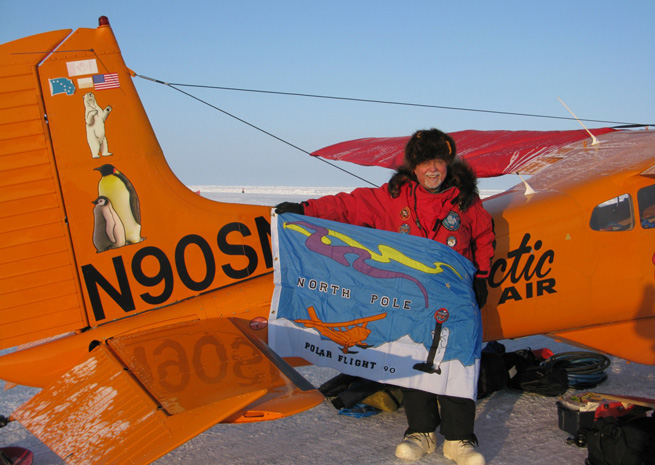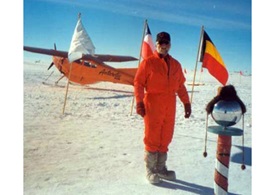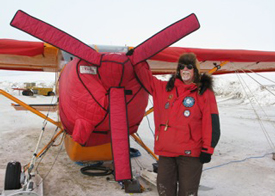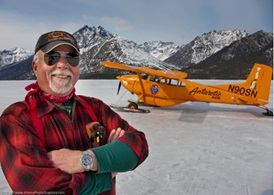
Art Mortvedt was a third of the way through his final leg to the North Pole when the windshield and wings of his Polar Pumpkin, a Cessna 185 painted bright orange and fitted with skis, began to ice up. Mortvedt, 63, had a tough decision to make. Turning back to Eureka (a polar research base on Ellesmere Island, Nunavut, Canada, barely below 80 degrees North) would spell the end, for 2013, at least, of Mortvedt’s quest to fly his single-engine Cessna to both ends of the Earth. Pressing on through icing conditions would cost him his aircraft, and quite possibly his life.
“I realized that search and rescue was just about impossible. Was impossible, really,” Mortvedt said, recalling the potential consequences of an off-airport landing above 80 degrees north latitude in a telephone interview with AOPA Online. “If I could get out of there, I’d be lucky, but the airplane was going to be history.”
Mortvedt flew his Polar Pumpkin to the South Pole in 1999, one of his 27 missions to Antarctica, and also had more than 30 years of Arctic experience to bring to bear on the decision. He also had a satellite telephone connection to his wife (and fellow Arctic adventurer, explorer, and resident), Damaris, who provided a line of communication with Russian scientists and support crew at Barneo, an ice station where he planned to land within miles of the planet’s northern limit. (Barneo is a seasonal operation set up in the last days of March each year on the sea ice a few miles from the North Pole.) News on that front was good—there was no fog at Barneo to foil a landing, though Mortvedt would soon see clouds moving in on his destination that could force the narrow weather window closed. April is the only month of the year during which such a flight is possible: Fog becomes a chronic problem as the Arctic basin warms by month’s end; the long polar night and brutal cold preclude winter attempts. On April 6, Mortvedt was attempting the flight for the third time in as many years, drawing fuel from cached barrels of avgas he had shipped from Montreal to various stops along the way.
As the ice accumulated, Damaris suggested (and her husband considered) turning back, cutting the attempt short about 200 nautical miles north of Eureka, 400 miles short of 90 degrees north.
“Fortunately I was able to climb out of it,” Mortvedt recalled, noting the ice accumulation stopped once he topped about 3,000 feet. “This was my one chance and I had to do it. Thank the good Lord, I did it … we did it.”

Mortvedt flew 7.5 hours from Eureka to reach his goal, and saw clouds moving in toward Barneo, the only safe place to land for miles around. Knowing fuel was tight, he had already marked on his Garmin 496 GPS a pair of potential landing spots to the south, where he could land and hunker down in the frigid cold (about minus 30 degrees Fahrenheit) to plan a next move.
At 2 a.m. (local time in a Russian time zone), the Polar Pumpkin’s skis touched Arctic ice graded days before by bulldozers air dropped by Russian Air Force pilots to prepare the way for an Antonv An-74 landing with more cargo, and passengers. A relieved Mortvedt was greeted by Russians who had stayed up to offer a hot meal and direct him to his waiting fuel.
“The Russians were fantastic,” Mortvedt said. After getting a few hours of sleep, he walked in to breakfast and another warm welcome from fellow Arctic (and Antarctic veterans). Mortvedt said it is a close-knit community, one where shared experience trumps nationality or creed. “Everybody gave me a round of applause for having finally made it on the third try.”
‘A real surprise’
With surface temperatures far below freezing, Mortvedt had had little reason to expect his icing encounter, but the Arctic has a nearly limitless capacity to surprise even the most experienced adventurer. Mortvedt is among the more experienced, having built in 1981 and operated since 1986 (with his wife and the couple’s partner, Bernice Sheldon) a lodge on Alaska’s Selby Lake, perched on the southern flank of the Brooks Range just above the Arctic Circle. No stranger to flying the high Arctic latitudes (not to mention the corresponding southern latitudes), Mortvedt said the ice that nearly forced him to abandon his April attempt was “a real surprise,” most likely created by moist air rising from the scarce stretches of open water, or “open leads.”
Surprise ice was far from the only peril: This is a land of polar bears, huge carnivores that can stand 12 feet tall on their hind legs and will happily add humans to their menu.
Mortvedt said firearms were among the essential tools of survival he packed into the Polar Pumpkin, along with enough food to survive 48 days if stranded. He would have liked to bring an electric fence (which he could power with the Honda generator carried to run the Tanis Aircraft Products electric heaters that, along with blankets, kept his aircraft warm when stopped), but an electric fence was simply too heavy.
“Electricity is one thing I found that bears don’t really like at all,” Mortvedt said, lamenting the strict weight limit. “I did have a motion sensor that makes a heck of a loud squealing.”
Years before, during another Arctic expedition in the 1980s, a trio of polar bears wandered within a few feet of his camp, surprising Mortvedt. He came within a whisker of being dinner.
“Those bears must have been well-fed,” Mortvedt recalled of that encounter. He made enough racket with the scrap wood used to build a privy to drive the bears a few feet back, just enough to give him space to dive for his tent, where a high-powered rifle was waiting. “I managed to get to my tent and grabbed the rifle … started shooting into the snow,” Mortvedt recalled, noting the gunfire prompted the bears to back off. He said that encounter was a “pretty close” call.
Polar bears have been known to stalk humans for days on end, biding their time for the right moment to strike. “They’re very good (hunters),” Mortvedt said.
The frigid air can kill airplanes in more ways than one.

Mortvedt carried a multi-fuel stove as a backup in case the generator failed (along with spare parts for the generator). Arctic pilots cannot afford to let their airplane freeze, nor can the battery be allowed to succumb to cold, Mortvedt said:
“I try to heat everything from the nose to the battery. There’s no hand-propping a Cessna.”
‘Lucky to have gotten off the ice’
Mortvedt stayed at Barneo—named with a sense of humor for the tropical island Borneo in Southeast Asia—for two days before heading back south. The 600-mile trek to Eureka was uneventful, but a change in weather then forced a long stop.
“I got stuck there for two weeks,” Mortvedt recalled. “I’m lucky to have gotten off the ice back on terra firma when I did.”
A member of the Explorers Club, Mortvedt has carried (lightweight) instruments and cameras on his journeys north to gather data for scientific research. In 2012, he gathered 36 gigabytes of polar imaging data for NASA, and in 2013, carried an instrument to measure atmospheric carbon for the University of Alaska.
Mortvedt has no plans to retire, and wouldn’t rule out another polar flight in the Pumpkin for science—he still has a few barrels of avgas cached in the high Arctic. Gathering “credible polar science” has been Mortvedt’s primary goal, he said. Primacy—being the first to overfly both poles in a single-engine aircraft, was once thought to be a nice bonus, though an Australian beat him to it: An RV-4 built and piloted by Jon Johanson overflew 90 degrees north in 2000, and 90 degrees south in 2003 (ironically, using fuel Mortvedt had cached for another aviator).

Mortvedt has posted a detailed chronicle of his own Arctic adventure online, and is also contemplating a book. Meanwhile, he is keen and able to speak to groups, conventions, seminars, and the like to tell the story of the Polar Pumpkin and its remarkable odyssey. (He welcomes anyone interested to email him.)
Mortvedt will attend EAA AirVenture 2013 in Oshkosh, Wis., and will not be hard to find—just look for the bright orange Cessna. Also watch for an interview with Mortvedt on AOPA Live.
Arctic survival
Art Mortvedt was prepared to survive in the event of an unplanned stop in the high Arctic. He wore layers including a down-filled flight suit, and "Bunny Boots," the extreme cold-weather footwear of the U.S. military.
To keep his Cessna 185 warm, Mortvedt packed insulated covers and heaters by Tanis Aircraft Products, powered by a Honda portable generator. He also had an MSR XGK stove, which can run on multiple fuels including avgas, both to melt ice or snow for drinking water, and as a backup aircraft heater in case his electric heaters failed. Mortvedt packed enough food for 48 days, and his ditching case also included a backup GPS, along with a GPS tracker and emergency beacon. A satellite telephone rigged through his headset allowed Mortvedt to keep in touch with his wife, who could obtain weather briefings for planned stops, and also provide a welcome voice to talk to along the way.
Polar bears are a threat Mortvedt takes seriously, and he packed a Remington 870 shotgun, with both buckshot and slug.
"I felt I was self-sustaining over a month," Mortvedt said.



